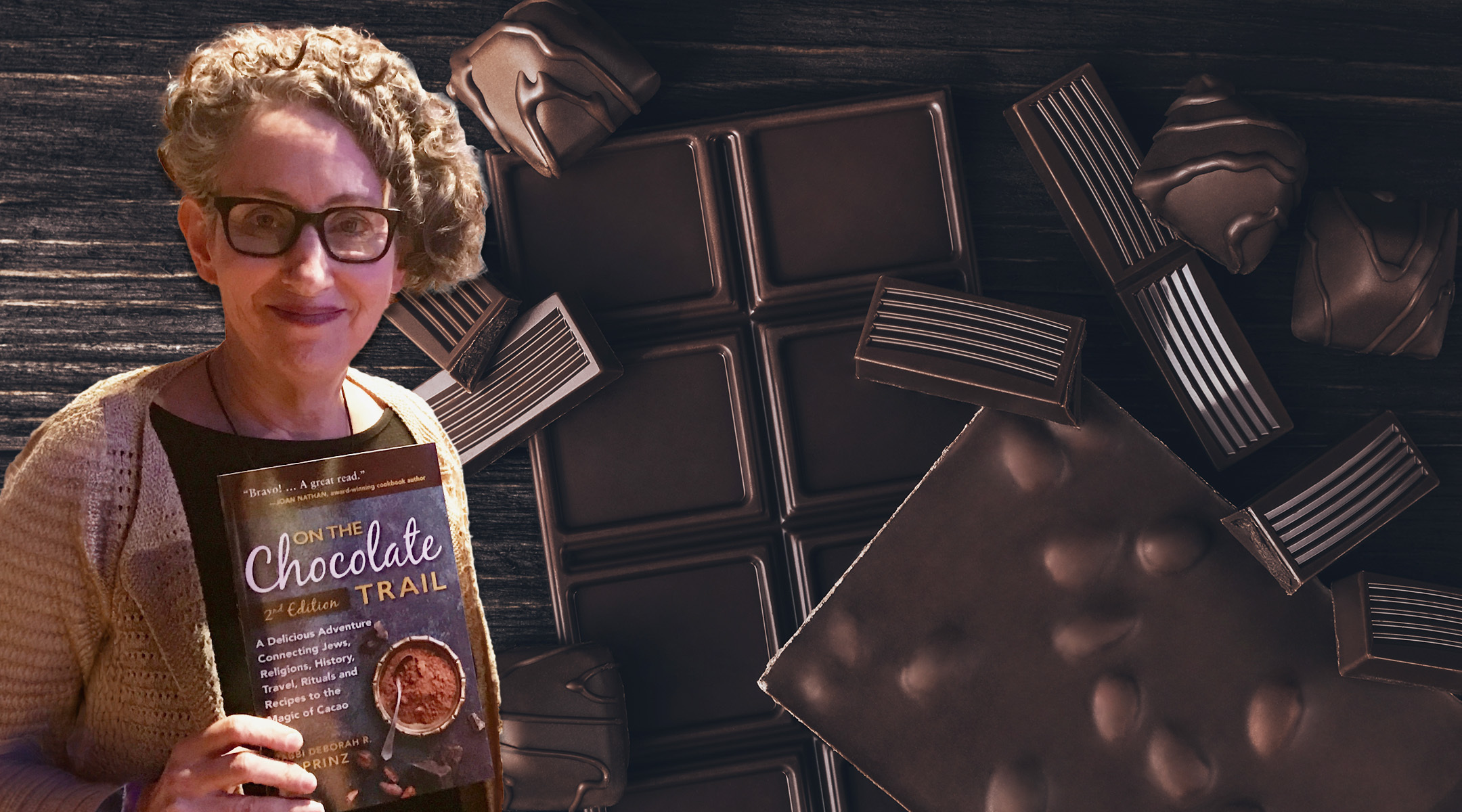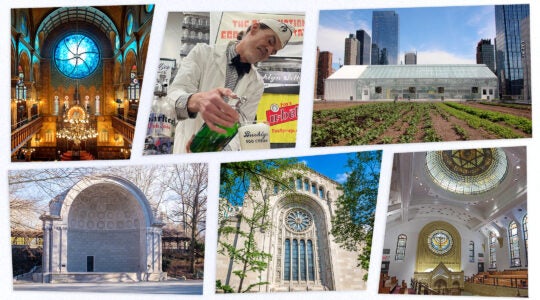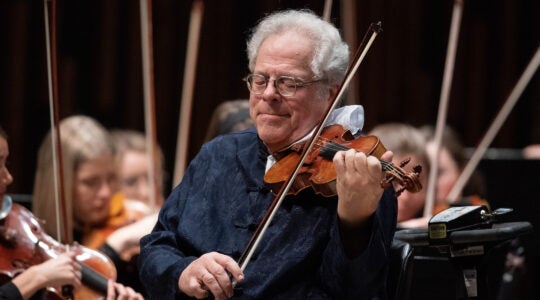(New York Jewish Week) — In 2006, Rabbi Deborah Prinz was on a trip to Europe with her husband, Rabbi Mark Hurvitz, when they wandered into a chocolate shop in Paris. While meandering about the store, Prinz picked up a brochure and read a line that, given her rudimentary French, she was sure she misunderstood: It claimed that Jews had brought the art of chocolate-making to France.
Prinz, who at the time was the congregational rabbi at Temple Adat Shalom in Poway, California, was stunned. That little morsel of information stayed with her throughout her 10-week sabbatical — and ended up being a defining moment of her life: For the next several years, Prinz followed the zigzagging trail of chocolate, from the rainforests of the New World to the cities of the Old World and, from there, to the American colonies, hoping to clarify the role that Jews played in the making, marketing and trading of chocolate.
Prinz, who now lives in New York, was fascinated by the connection between Jews and chocolate, and the overlap between the dispersion of the Jews and the expansion of the chocolate market across the globe. Her research culminated in a book, “On the Chocolate Trail: A Delicious Adventure Connecting Jews, Religions, History, Travel, Rituals and Recipes to the Magic of Cacao,” which she published a decade ago.
A second edition came out in 2018, with a new chapter about the controversies over chocolate likenesses of deities, as well as updated information about chocolate museums and factory tours around the world.
Now, an exhibit detailing the rich history of Jews and chocolate in this country, “Sweet Treat: Chocolate and the Making of American Jews,” is on view at Manhattan’s Central Synagogue, where Prinz began her career as the Reform congregation’s first female rabbi. The exhibit is a pared-down, American-specific version of an exhibit Prinz co-created in 2017 with the Bernard Museum at Temple Emanu-El on the Upper East Side, ““Semi[te] Sweet: On Jews and Chocolate.”
Chocolate, and humankind’s love affair with it, dates to pre-Columbian peoples in Mesoamerica who used chocolate in their religious rituals. Jewish involvement in chocolate parallels the movement of the Jewish people, beginning with Sephardic Jews of Iberian descent in the 16th and 17th centuries, Prinz said by email. Sephardic Jews, she said, probably engaged with chocolate soon after the first European contact with it, which is said to have occurred during Columbus’ fourth voyage (1502-1504).
“Jews jumped onto the chocolate trail in the early phases of European interaction with the New World and they introduced the drink [of hot chocolate] in diasporic places such as New Spain (now Mexico), Oxford (England), Martinique, Amsterdam, Bayonne (France), Brabant (Belgium), New York and Newport (Rhode Island),” Prinz told the New York Jewish Week by email, adding that their action “created a path of business interests and appetites that continues in our time. These included chocolate entrepreneurs who fostered, perpetuated, and fed an appetite for the drinking chocolate of the day.”
Based upon Prinz’s years of research, the exhibit sheds light on some of the key Jewish players in the Colonial-era chocolate trade, including Aaron Lopez, a Sephardi immigrant, merchant and slave trader who became one of the wealthiest men in Newport, Rhode Island. Lopez, an observant Jew, gave chocolate as part of his tzedakah food packages to poor members of the Jewish community. He also helped build the historic Touro Synagogue, which today is owned and overseen by New York’s Congregation Shearith Israel, the oldest Jewish congregation in the United States, also known as the Spanish and Portuguese Synagogue.
The chocolate exhibit is a “micro history,” according to Rabbi Sarah Berman, Central Synagogue’s director of adult education. By examining the surprising role the Jews played in the chocolate trade in this country, the exhibit, which is on display at the Sanctuary Building, across the street from the synagogue, is “one way of understanding how Jews and Jewish culture came together in this country and began to define itself from the colonial period forward.”
As for the decision to mount an exhibit about chocolate at the Midtown synagogue, Prinz wrote in an email that Jews’ involvement with chocolate is “a sweet, yet little-known aspect of the Jewish experience. Also, a number of the stories are New York based. And finally, it offers up important themes of sustenance, resilience, opportunity and hope.”

On display is a facsimile of a map of 15th-17th century dispersions of Sephardi Jews and their relationship to historic chocolate centers. (Courtesy Rabbi Mark Hurvitz)
Among the items on display in the small exhibit is a map of the dispersions of Sephardi Jews in the 15th to 17th centuries, which shows how the areas where Jews settled correspond with early centers of the chocolate trade, as well as an image of Albert Einstein’s personal hot chocolate cup, which he brought with him when he left Germany for the United States in 1933.
“In Jewish life and tradition, we often look to rabbinic texts to understand who we are and how we move through the world over time. Texts are wonderful, but they preserve the reality, the lived experience and the scholarship of a certain class of men in certain times and places,” Berman said, adding, “Objects in art tell a different story, maybe a fuller story about who we are.”
Also featured in the exhibit are Lopez’s cousins, the Gomez family, who were leaders of New York’s Jewish community and major donors to Congregation Shearith Israel. They, too, were involved in the chocolate trade: Rebecca Gomez, widow of Mordecay Gomez, may have been the only Jewish woman in the chocolate business in the late 1700s. On display is a facsimile of an ad for her chocolate business at 57 Nassau St. in Lower Manhattan that ran in The Royal American Gazette, a New York newspaper, on Dec. 3, 1782.
The exhibit also touches on more recent Jewish chocolate entrepreneurs in this country, including Stephen Klein, who launched Barton’s Bonbonniere in New York in 1940. Just before the outbreak of World War II, Klein, whose family members were candymakers in Austria, fled to this country and soon thereafter began selling chocolates door-to-door. From there, he eventually expanded to 3,000 shops across the country, creating iconic candies such as almond kisses and the chocolate lollipops known as lollycones. For many Jewish families in the 1950s and 1960s, Barton’s candy was the hostess gift for the Jewish holidays.
What’s more, as an Orthodox Jew, Klein used his candy business to further educate Jews and non-Jews alike about Judaism. Klein, said Prinz, was an “immigrant who helped other immigrants come over. He ran full page ads [in newspapers] with information about Judaism, holidays and Israel. Barton’s candy boxes included inserts about Judaism and Jewish holidays. Like the Maxwell House coffee company, Barton’s designed a Passover haggadah, too.”
Jewish chocolate products also influenced the most American of all beverages: fountain drinks. The story of the egg cream, which most people believe was created at the start of the 20th century by a Jewish immigrant, is detailed in the third part of the exhibit, “Ooey, Gooey, Chocolatey Treats.” The exhibit details how a Jewish family also created Fox’s U-Bet chocolate syrup which many consider essential to a proper egg cream. In the 1920s and ‘30s, Louis Auster, who is credited with creating this poor man’s soda drink, reportedly sold 3,000 egg creams a day 3 cents a glass — and up to 12,000 on sweltering summer days, according to Barry Joseph, author of “Seltzertopia.”
As a whole, the exhibit, which is on view until Feb. 9, 2024 and is open to the public on Wednesdays from 12:30-2 p.m. and Fridays after Shabbat services, presents a comprehensive look at the long history of both Jews and chocolate in this country. “Integration [of Jews] into wider society, the acculturation, the influence going back and forth from Jewish to American and back to Jewish cultures can all be traced through those early days,” said Berman, “and chocolate is an example.”
According to Prinz, looking at American Jewish life through the lens of chocolate helps us “understand the resiliency of Jews exiled from Spain and then immigrants from the Holocaust as they sought freedom, acclimated to new settings, and found new business ventures in America,” she wrote in an email to the New York Jewish Week. “Our ancestors overcame persecution and oppression, in part through chocolate. Their chocolate endeavors in America from its earliest days reminds us that Jews were part of the founding of our country.”
The New York Jewish Week brings you the stories behind the headlines, keeping you connected to Jewish life in New York. Help sustain the reporting you trust by donating today.





